Best of Things, Mountain-Bikes -
The 7 Best Hardtail Mountain Bikes in 2020
In the market for the best hardtails you can get your hands on?
If budget is not your primary concern, but instead you want to know what’s out there when it comes to the top of the line models, then you’re on the right page.
I’m talking about a lightweight (sub 20 lbs.) model specced with an electronic shifting drivetrain which will no doubt attract a lot of attention from other mountain bikers.
On this page, I’ll discuss what typically goes into a top-end model and share some of the popular models available from the leading brands.
A Quick Glance : Our Favorite Hardtail MTBs
| Models | Groupset | Weight |
|---|---|---|
| S-Works Epic | SRAM XX1 Eagle AXS | 8.6 kg / 18.9 lbs |
| Santa Cruz Highball | SRAM XX1 Eagle AXS | 9.2 kg / 20.3 lbs |
| Scott Scale RC900 | SRAM XX1 Eagle AXS | 9.5 kg / 20.9 lbs |
| Canyon Exceed CF SLX | SRAM XX1 Eagle AXS | 9.0 kg / 19.8 lbs |
| Giant XTC Advanced | SRAM XX1 Eagle AXS | 10.0 kg / 22.0 lbs |
| Trek Procaliber 9.7 | SRAM NX Eagle | 11.0 kg / 24.3 lbs |
| BMC Teamelite 01 | SRAM GX Eagle | 10.2 kg / 22.5 lbs |
S-Works Epic
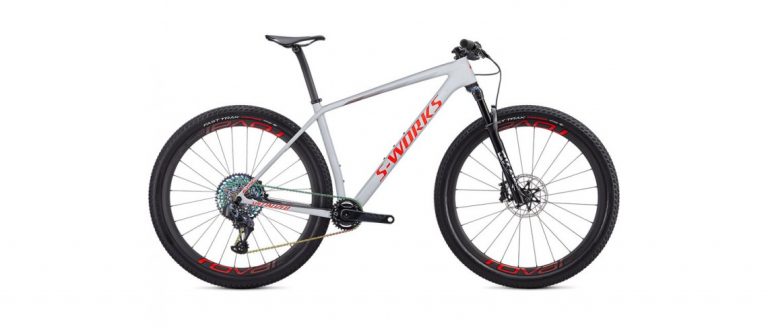
- Frame Material : Carbon
- Gearing : SRAM XX1 Eagle AXS, 12 Speed
- Weight : 8.6 kg / 18.9 kg
If it’s tagged with the S-Works label, Specialized’s top brand line, then you know it has to be incredible.
And that’s exactly what the aptly-named S-Works Epic is. Specialized’s top-of-the-line hardtail is equipped with all the high-end features you’d expect in an S-Works bike.
That means a stiff and ultra-lightweight carbon frame. It also means a state of the art components. The drivetrain is SRAM’s wireless XX1 Eagle AXS with an integrated power meter. Brakes are SRAM Level Ultimate hydraulic discs.
The 12-speed rear cassette offers a massive 10-50T range with a 30T chainring. Yes, the S-Works Epic is loaded with eye-popping features. The RockShox SID Brain Ultimate fork automatically adjusts the tension on your fork based on the terrain.
Weight savings can be found throughout the bike. There’s the wheelset, which features hookless carbon rims with a lightweight Fast Track tire and a carbon seat post, saddle, and handlebars.
- Pros : Very lightweight at 8.6 kg.
- Cons : Expect to pay a premium over other brands.
Santa Cruz Highball
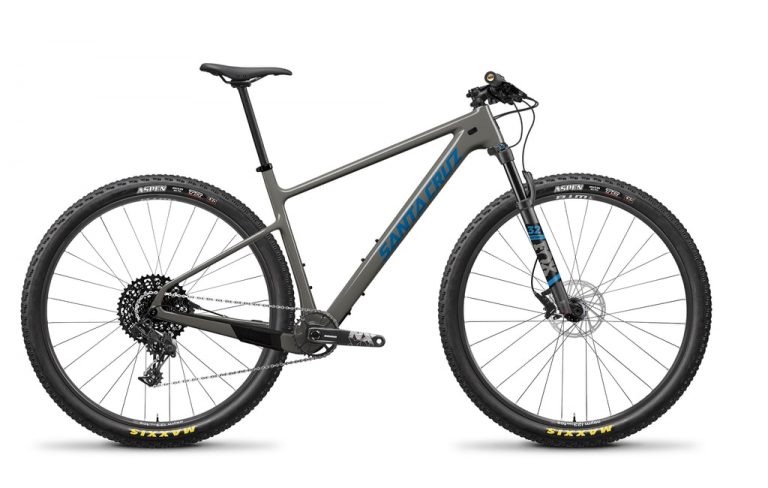
- Frame Material : Carbon
- Gearing : SRAM XX1 Eagle AXS, 12 Speed
- Weight : 9.2 kg / 20.3 lbs
One of the first things you’ll notice about the Santa Cruz Highball is the frame geometry.
The seat stays connected to the seat tube well below the top bar. This has the effect of creating a very small rear triangle on the frame. Santa Cruz says this innovative design dampens road chatter, making it smoother than most other hardtails.
This innovative design is supported by the top-of-the-line components. The highest of the Highball lineup is fitted with SRAM XX1 Eagle AXS build kit with a huge 10-50T range of gears in the rear cassette. SRAM Level Ultimate brakes complete this package of components.
The Santa Cruz Highball is also lighter thanks to carbon rims, seat post, and handlebars. It weighs in at just 9.2 kg.
- Pros : Unique rear frame geometry helps dampen uneven terrains.
- Cons : Boring color schemes.
Scott Scale RC900
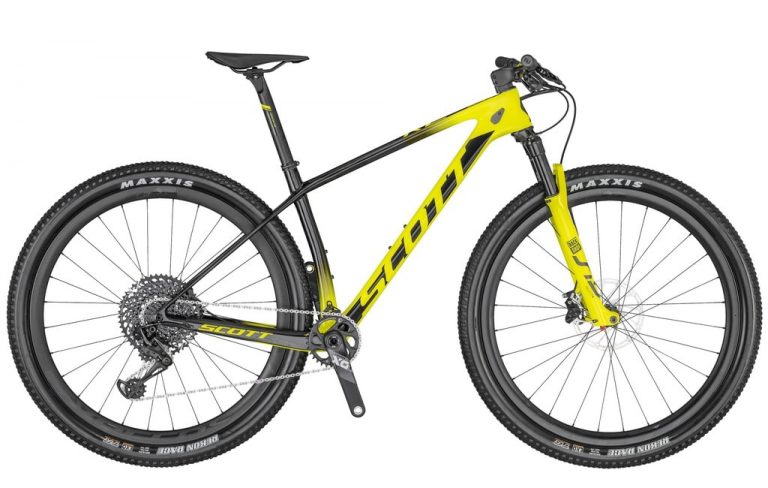
- Frame Material : Carbon
- Gearing : SRAM XX1 Eagle AXS, 12 speed
- Weight : 9.5 kg / 20.9 lbs
To put it simply, Scott’s Scale RC 900 is one badass-looking hardtail.
If that black and yellow color scheme doesn’t grab you, surely those rims and tires must. Looks certainly aren’t all that this bike has going for it.
There is plenty to love about the Scott Scale RC 900. Carbon construction is present throughout this bike from the frame to the handlebars, to the seat post and the saddle, making it not only one of the stiffest but also one of the lightest carbon bikes you can buy at just over 9 kg.
Components are state of the art with wireless SRAM XX1 Eagle AXS 12 speed. The drivetrain includes a 10-50T rear cassette and a 32T crankset. Brakes are SRAM Level TLM Disc with a 180mm front rotor for excellent stopping power.
- Pros : One of the lightest mountain bikes around after the S-Works Epic.
- Cons : 1 paint job choice only.
Canyon Exceed CF SLX 9.0
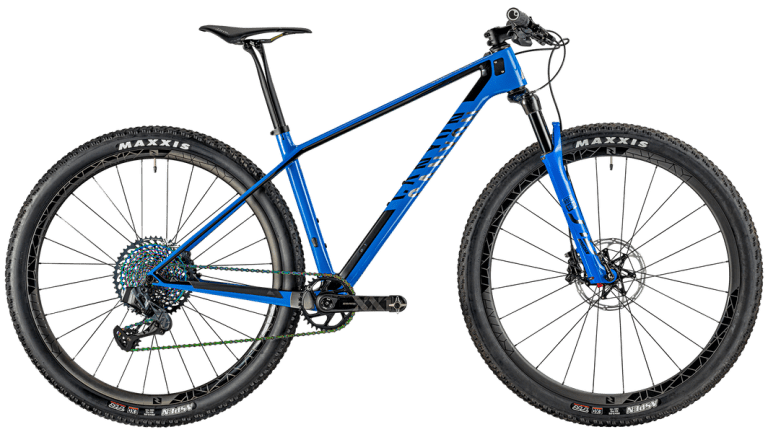
- Frame Material : Carbon
- Gearing : SRAM XX1 Eagle AXS, 12 Speed
- Weight : 9.0 kg / 19.8 lbs
Canyon’s known for its lightweight bikes, and the Exceed CF SLX 9.0 Race is no exception.
Weighing in at a hair under 9 kg, it’s one of the lightest models alongside Scott Scale RC900 and S-Works Epic. The weight savings is apparent throughout the bike from its RockShox SID Ultimate Carbon suspension fork to the Reynolds Blacklabel XC 259 carbon wheels, which weigh 1.4 kg.
The Canyon Exceed seems to shave off grams in every possible place. You’ll also find carbon construction in the handlebars, seat post, and saddle.
As you might expect, the components are top tier with SRAM XX1 Eagle AXS wireless shifting. The drivetrain, of course, features a carbon crankarm. The brakes are SRAM Level Ultimate with carbon levers and lightweight calipers.
- Pros : Excellent value for money with Canyon’s direct-to-consumer business model.
- Cons : Stock might be hard to come by.
Giant XTC Advanced
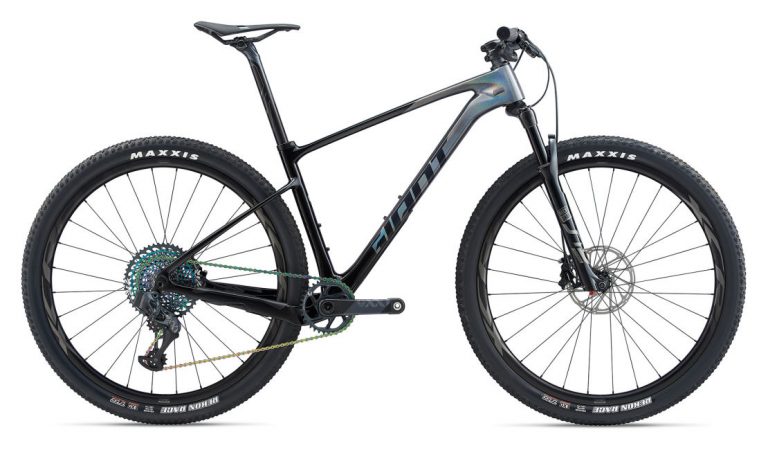
- Frame Material : Carbon
- Gearing : SRAM XX1 Eagle AXS, 12 Speed
- Weight : 10.0 kg / 22.0 lbs
Giant’s 2020 version of the XTC features a frame that has been redesigned to improve the geometry and cut weight.
This makes it one impressive bike. The frame weight is down to 920g. While that’s not on par with some other high-end models, it does put it in the ballpark.
This new iteration of the Giant XTC also features lower seat stays, which improves compliance. The fork is a RockShox SID Ultimate Debon Air carbon fork with remote lockout.
Components are top of the line with 12-speed SRAM Eagle AXS while brakes are SRAM Level Ultimate hydraulic disc. In addition to that, the tires and rims are tubeless-ready, which is a nice bonus.
- Pros : Top-of-the-line components at mid-tier price points.
- Cons : Heavier compared to other brands.
Trek Procaliber 9.7
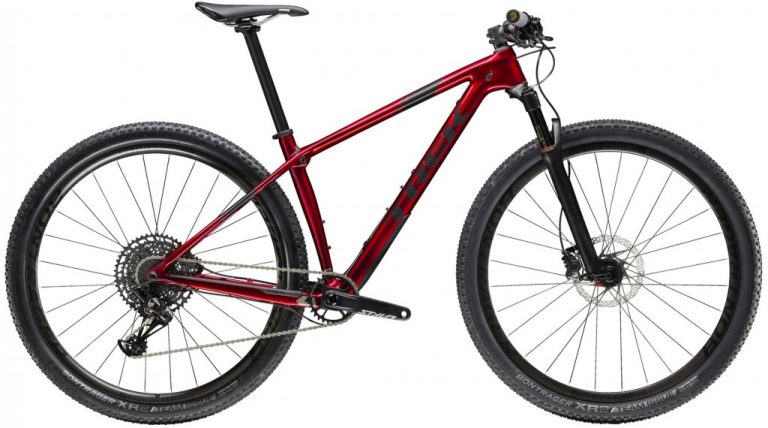
- Frame Material : Carbon
- Gearing : SRAM NX Eagle, 12 Speed
- Weight : 11.0 kg / 24.3 lbs
Trek has put together a surprisingly affordable race bike with the Procaliber 9.7.
While you may not find all the bells and whistles you see on some of the tops of the line models other manufacturers are putting out, the Trek Procaliber is certainly no slouch.
The frame is Trek’s OCLV Mountain Carbon and features its patented IsoSpeed system. Its Trek’s proprietary road dampening technology involves decoupling the frame at the seat post for shock absorption. Combined with a RockShox Reba RL suspension forks, the Procaliber is one smooth ride.
The drivetrain is the 1×12 SRAM NX Eagle with an 11-50t range on the rear cogset and a 30t chainring. Trek also gives you a set of Bontrager Kovee Elite tubeless-ready carbon wheels.
At a fraction of the cost of other top-end hardtails, the Trek Procaliber 9.7 is a great deal.
- Pros : IsoSpeed system provides additional dampening properties on the rear.
- Cons : Expect to pay slightly more for the Trek branding.
BMC TeamElite 01
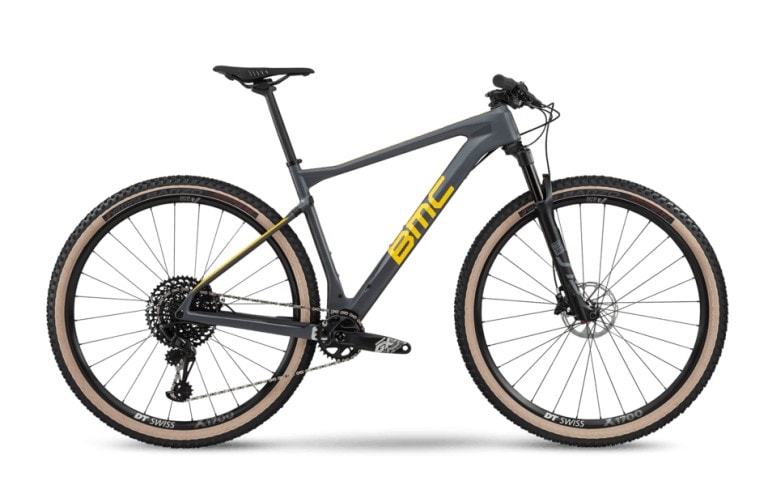
- Frame Material : Carbon
- Gearing : SRAM GX Eagle, 12 Speed
- Weight : 10.2 kg / 22.5 lbs
BMC has introduced its latest micro-suspension technology called the Micro Travel into the TeamElite 01.
Micro Travel adds 15mm vertical rear wheel movement to this bike, making this one of the comfier models you can find. Equipped to this impressive frame are a host of equally reliable components, including a mechanical SRAM GX Eagle 1×12 drivetrain with a 10-50T rear cog set and 32T chainring.
The BMC TeamElite 01 also shaves weight and adds dampening through a carbon seat post and handlebars. While the Teamelite may not have the super high-end components of other top-end hardtails, it does offer great value at a relatively lower price tag.
- Pros : Good value for money for a mid-tiered mtb bike.
- Cons : No electronic shifting.
What to Expect in Top of the Line Hardtails
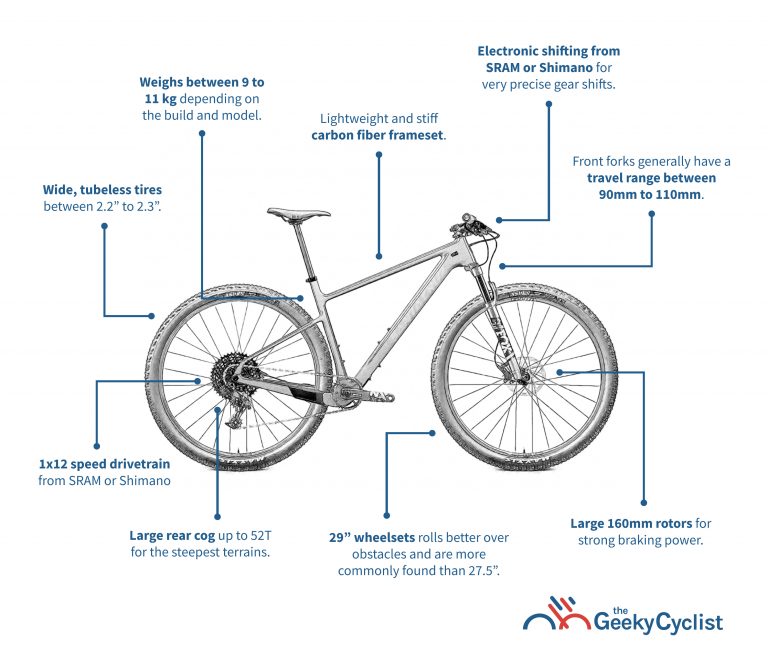
As with many things, there are different features and expectations when it comes to mountain bikes with different pricing levels.
One of the most commonly asked questions,
What can I expect in the best models besides the premium pricing?
To start things off, you’d be looking at the top-of-the-line bikes from all the leading mountain bike brands such as Specialized, Santa Cruz, and Scott.
Here’s a quick summary of what you can expect.
- A lightweight and fast bike
- Lightweight carbon frames
- Top of the line, 1×12-speed drivetrain
- 29″ wheel sizes with 2.25″ wide tires
- Weighs between 9 to 11 kg
Let’s take a deeper look at each of them below.
1. A Lightweight and Fast Bike
These bikes are designed for cross-country riding with lightweight frames and fast tires. This means generally a higher riding speed over easy to moderate trails.
Hardtail bikes sacrifice stability for responsiveness with a shorter wheelbase and steeper head tube angle, facilitating quick turns while moving at high rates of speed.
On the other hand, trail bikes are designed for more technical terrains (eg: rock gardens) with rear suspension systems, steeply dropped top tubes, and beefier tires. These attributes make trail bikes better adept at handling difficult terrain but also notably heavier.
Downhill suspension bikes are designed for large jumps with large suspension systems and thick tires. They also feature longer wheelbases and steeper head tube angles to facilitate better stability on downhill runs.
Read More : A Beginner’s Guide to Mountain Bikes
2. Bike Frame Made from Carbon
High-end bikes are going to have the best frame materials. And the best is carbon.
Carbon is the stiffest and lightest frame material out there, so expect to find it on all top end bikes.
It also happens to be the most expensive material, which is why you won’t find it on bikes at cheaper price points. That said, there are a few things to consider here as not all carbon is created equal.
Carbon layup which refers to how the fibers of carbon are woven together can affect the ride quality in terms of how stiff or compliant a frame is. As such, this is something you might want to pay attention to when making a decision.
3. Top of the Line, 1x12-Speed Drivetrain
Since we are talking about the best of the best, expect to find the best of its kind components at this price point. SRAM dominates this market segment over Shimano.
And the best SRAM offers is its wireless XX1 Eagle AXS.
Bikes such as Canyon’s Exceed and Specialized’s S-Works Epic are fitted with these components.
Those that are in the slightly lower range will offer a step down to SRAM GX Eagle, which is mechanical only. The low-tiered SRAM SX Eagle and NX Eagle are usually found in mountain bikes around the $2,000 price range.
All high-end mountain bikes have adopted what has now become the industry standard: a 1×12 drivetrain.
Why?
A 1×12 drivetrain with a 10-50T rear cog set maximizes performance and shifting efficiency by eliminating the need for a front derailleur.
4. Hydraulic Disc Brakes with Massive Stopping Power
Disc brakes are entirely hydraulic at this price point with at least 160mm rotors on the front and back. These larger disc rotors provide plenty of stopping power and won’t overheat as quickly as smaller rotors.
A few models, including the Scott Scale RC 900, include 180mm rotors in the front to add even more stopping power. Hydraulic brakes offer more power and better modulation when braking compared to mechanical brakes.
Read More : A Beginner’s Guide to Bicycle Disc Brakes
5. 29" Wheelset with 2.25" Wide Tires
Most of the models come with a 29″ wheel paired with 2.2″ to 2.3″ wide tires.
The 29ers offer better rollover, meaning that they will more easily roll over obstacles, and traction due to their larger surface area. Maintaining higher speeds with 29ers is easier.
The tires are generally narrower than trail or downhill tires and with lighter tread to facilitate better roll and hence higher speeds.
6. Weighs Between 9 to 11 kg
At this level riders expect these bikes to be race-ready. And race-ready means lightweight.
Keep in mind that you will pay a premium for that weight savings.
As such, manufacturers will seek to use lightweight carbon throughout the bike to maximize weight savings. This includes not just the frame, but also the fork, wheelsets, seat post, handlebars, and saddle.
Those high-end components are also the lightest you’ll find on the market. This all adds up to very low numbers when it comes to weight.
Expect the top cross country mountain bikes to weigh somewhere between 9 and 11 kg. Specialized’s S-Works Epic actually comes in under the 9 kg mark while the Trek ProCaliber 9.7 is just under 11 kg.
Author Recommended Reads
